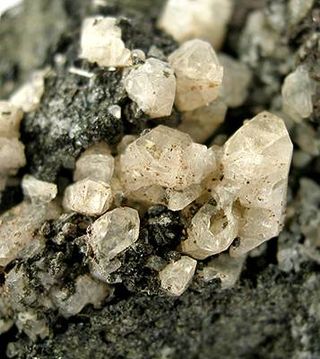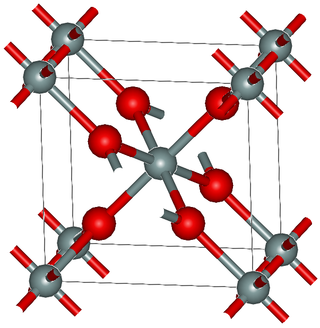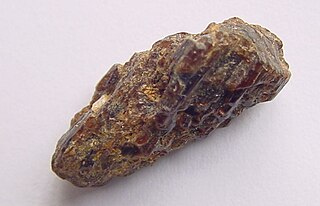Related Research Articles

Anorthite (an = not, ortho = straight) is the calcium endmember of the plagioclase feldspar mineral series. The chemical formula of pure anorthite is CaAl2Si2O8. Anorthite is found in mafic igneous rocks. Anorthite is rare on the Earth but abundant on the Moon.

Stishovite is an extremely hard, dense tetragonal form (polymorph) of silicon dioxide. It is very rare on the Earth's surface; however, it may be a predominant form of silicon dioxide in the Earth, especially in the lower mantle.

Hedenbergite, CaFeSi2O6, is the iron rich end member of the pyroxene group having a monoclinic crystal system. The mineral is extremely rarely found as a pure substance, and usually has to be synthesized in a lab. It was named in 1819 after M.A. Ludwig Hedenberg, who was the first to define hedenbergite as a mineral. Contact metamorphic rocks high in iron are the primary geologic setting for hedenbergite. This mineral is unique because it can be found in chondrites and skarns (calc–silicate metamorphic rocks). Since it is a member of the pyroxene family, there is a great deal of interest in its importance to general geologic processes.

Braunite is a silicate mineral containing both di- and tri-valent manganese with the chemical formula: Mn2+Mn3+6[O8|SiO4]. Common impurities include iron, calcium, boron, barium, titanium, aluminium, and magnesium.

Painite is a very rare borate mineral. It was first found in Myanmar by British mineralogist and gem dealer Arthur C.D. Pain who misidentified it as ruby, until it was discovered as a new gemstone in the 1950s. When it was confirmed as a new mineral species, the mineral was named after him. Due to its rarity, painite can cost between US$50,000 to $60,000 per carat.

Oldhamite is a calcium magnesium sulfide mineral with the chemical formula (Ca,Mg)S. Ferrous iron may also be present in the mineral resulting in the chemical formula (Ca,Mg,Fe)S. It is a pale to dark brown accessory mineral in meteorites. It crystallizes in the cubic crystal system, but typically occurs as anhedral grains between other minerals.
Keilite is an iron-magnesium sulfide mineral with the chemical formula (Fe,Mg)S) that is found in enstatite chondrites. Keilite is the iron-dominant analog of niningerite. Keilite is named after Klaus Keil.
Niningerite is a magnesium–iron–manganese sulfide mineral with the chemical formula MgS that is found in enstatite chondrite meteorites. Niningerite is the magnesium-dominant analog of keilite. This mineral is named after Harvey H. Nininger.
Akimotoite is a rare silicate mineral in the ilmenite group of minerals, with the chemical formula (Mg,Fe)SiO3. It is polymorphous with pyroxene and with bridgmanite, a natural silicate perovskite that is the most abundant mineral in Earth's silicate mantle. Akimotoite has a vitreous luster, is colorless, and has a white or colorless streak. It crystallizes in the trigonal crystal system in space group R3. It is the silicon analogue of geikielite (MgTiO3).

Khatyrkite is a rare mineral which is mostly composed of copper and aluminium, but may contain up to about 15% of zinc or iron. Its chemical structure is described by an approximate formula (Cu,Zn)Al2 or (Cu,Fe)Al2. It was discovered in 1985 in a placer in association with another rare mineral cupalite. These two minerals have only been found at 62°39′11″N174°30′02″E in the area of the Iomrautvaam, a tributary of the Khatyrka river, in the Koryak Mountains, in Anadyrsky District, Chukotka, Russia. Analysis of one of the samples containing khatyrkite showed that the small rock was from a meteorite. A geological expedition has identified the exact place of the original discovery and found more specimens of the Khatyrka meteorite. The mineral's name derives from the Khatyrka zone where it was discovered. Its type specimen is preserved in the Mining Museum in Saint Petersburg, and parts of it can be found in other museums, such as Museo di Storia Naturale di Firenze.

Seifertite is a silicate mineral with the formula SiO2 and is one of the densest polymorphs of silica. It has only been found in Martian and lunar meteorites, where it is presumably formed from either tridymite or cristobalite – other polymorphs of quartz – as a result of heating during the atmospheric re-entry and impact to the Earth, at an estimated minimal pressure of 35 GPa. It can also be produced in the laboratory by compressing cristobalite in a diamond anvil cell to pressures above 40 GPa. The mineral is named after Friedrich Seifert (born 1941), the founder of the Bayerisches Geoinstitut at University of Bayreuth, Germany, and is officially recognized by the International Mineralogical Association.
CI chondrites, also called C1 chondrites or Ivuna-type carbonaceous chondrites, are a group of rare carbonaceous chondrite, a type of stony meteorite. They are named after the Ivuna meteorite, the type specimen. CI chondrites have been recovered in France, Canada, India, and Tanzania. Their overall chemical composition closely resembles the elemental composition of the Sun, more so than any other type of meteorite.

Grossite is a calcium aluminium oxide mineral with formula CaAl4O7. It is a colorless to white vitreous mineral which crystallizes in the monoclinic crystal system.
Krotite is a natural mineral composed of calcium, aluminium and oxygen, with the molecular formula CaAl2O4. It is the low-pressure dimorph of CaAl2O4, of which the high-pressure dimorph is named dmitryivanovite.

Sinoite is rare mineral with the chemical formula Si2N2O. It was first found in 1905 in chondrite meteorites and identified as a distinct mineral in 1965. Sinoite crystallizes upon meteorite impact as grains smaller than 0.2 mm surrounded by Fe-Ni alloys and the mineral enstatite. It is named after its SiNO composition and can be prepared in the laboratory as a silicon oxynitride ceramic.
Panguite is a type of titanium oxide mineral first discovered as an inclusion within the Allende meteorite, and first described in 2012.

Junitoite is a mineral with formula CaZn2Si2O7·H2O. It was discovered at the Christmas mine in Christmas, Arizona, and described in 1976. The mineral is named for mineral chemist Jun Ito (1926–1978).
Hexamolybdenum is a molybdenum dominant alloy discovered during a nanomineralogy investigation of the Allende meteorite. Hexamolybdenum was discovered in a small ultrarefractory inclusion within the Allende meteorite. This inclusion has been named ACM-1. Hexamolybdenum is hexagonal, with a calculated density of 11.90 g/cm3. The new mineral was found along with allendeite. These minerals, are believed to demonstrate conditions during the early stages of the Solar System, as is the case with many CV3 carbonaceous chondrites such as the Allende meteorite. Hexamolybdenum lies on a continuum of high-temperature alloys that are found in meteorites and allows a link between osmium, ruthenium, and iron rich meteoritic alloys. The name hexamolybdenum refers to the crystal symmetry and the molybdenum rich composition. The Allende meteorite fell in 1969 near Pueblito de Allende, Chihuahua, Mexico.
Yagiite is a cyclosilicate mineral belonging to the osumilite group. It was discovered in 1968 in the iron meteorite that fell in Colomera in the province of Granada (Spain). Named after the Japanese mineralogist Kenzo Yagi, its CAS Registry Number is IMA1968-020.
References
- ↑ Warr, L.N. (2021). "IMA–CNMNC approved mineral symbols". Mineralogical Magazine. 85 (3): 291–320. Bibcode:2021MinM...85..291W. doi: 10.1180/mgm.2021.43 . S2CID 235729616.
- ↑ Webmineral data
- ↑ Mindat.org
- 1 2 Mikouchi, T.; Zolensky, M.; Ivanova, M.; Tachikawa, O.; Komatsu, M.; Le, L.; Gounelle, M. (2009). "Dmitryivanovite: A new high-pressure calcium aluminum oxide from the Northwest Africa 470 CH3 chondrite characterized using electron backscatter diffraction analysis". American Mineralogist. 94 (5–6): 746–750. Bibcode:2009AmMin..94..746M. doi:10.2138/am.2009.3080. S2CID 55193804.
- ↑ "New minerals approved by the IMA-CNMNC in September 2010" (PDF). Archived from the original (PDF) on 2012-03-20. Retrieved 2011-05-09.
- ↑ Zolensky, M; Mikouchi, T (2010). "Structures of Extraterrestrial Minerals Revealed by EBSD". Microscopy and Microanalysis. 16 (S2): 676–677. Bibcode:2010MiMic..16S.676Z. doi: 10.1017/S1431927610056060 .
- ↑ Dougill, Maryon W. (1957). "Crystal Structure of Calcium Monoaluminate". Nature. 180 (4580): 292–293. Bibcode:1957Natur.180..292D. doi:10.1038/180292a0. S2CID 42936397.